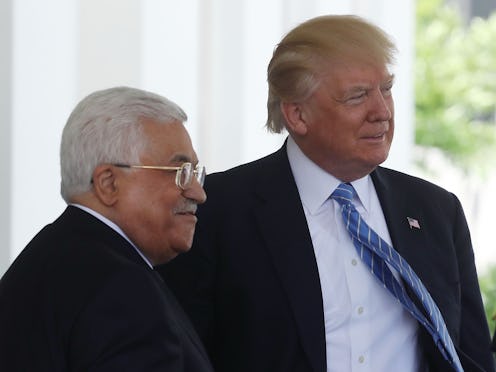
Donald Trump's assistant and director of social media, Dan Scavino, shared an interesting photo today on Twitter. In a tweet captioned "Happening now: @POTUS @realDonaldTrump, @VP Mike Pence, and President Mahmoud Abbas having a working lunch in the Cabinet Room," Scavino showed some top figures from the White House sitting in front of a Palestinian delegation spearheaded by their president, Mahmoud Abbas. The overwhelmingly male panel pointed to the White House's gender problem, specifically how the lack of women continues to highlight gender disparity in Trump's administration.
To be clear, this is not the first time something like this has taken place. It's happened before in Mike Pence's photo about the failed American Health Care Act — 25 white men speculating about health care for the entirety of the United States.
Some may object to nitpicking a photo like this by saying that the men present in the photo (on both sides) are fully aware of the complexities in regional politics, especially in the controversial context of the Israeli-Palestinian conflict. But the photo is worth studying in order to understand how — apart from the lone woman at the very end of the table — no woman is present to discuss decision-making for a region embroiled in constant strife; America's policies on the Middle East not only affect hundreds of thousands of women, but also has an impact on the daily lives of Palestinian women and girls.
Taking this photo apart seems trivial on the surface, but it brings attention to a larger and unavoidable issue in politics: participation. The rationale for keeping women present in terms of decision-making events is strongly supported by the United Nations, specifically through its department geared toward economic and social affairs, and its division centered on the advancement of women which advocates for equal contribution from men and women in politics. It's for a simple reason. Women know and experience their conditions and circumstances more immediately and are better equipped to provide their opinions stemming from experiential insight.
It goes without saying that the Israeli-Palestinian conflict affects not only men of the region, but also women. By bringing women to the table — literally and figuratively — both governments have a more realistic chance at making better decisions for public and private sectors in the region, along with academic institutions and other organizations.
While women are not a homogeneous group of people and are not solely defined by their sex, different women can bring different perspectives into consideration at these meetings — which is especially consequential for people on both sides of the conflict. This means a more wholesome factoring of socioeconomic standing, religious beliefs, and other fundamental characteristics that need to be evaluated in such high-level meetings.
With one female figure at the end of the table, this meeting seems to fall far too short in addressing the needs of everyday women in that specific region. Decision-making on this level inevitably affects everyone. Keeping representatives and voices from half of the demographic away from the table is counterproductive to making strides in progress, to say the least.